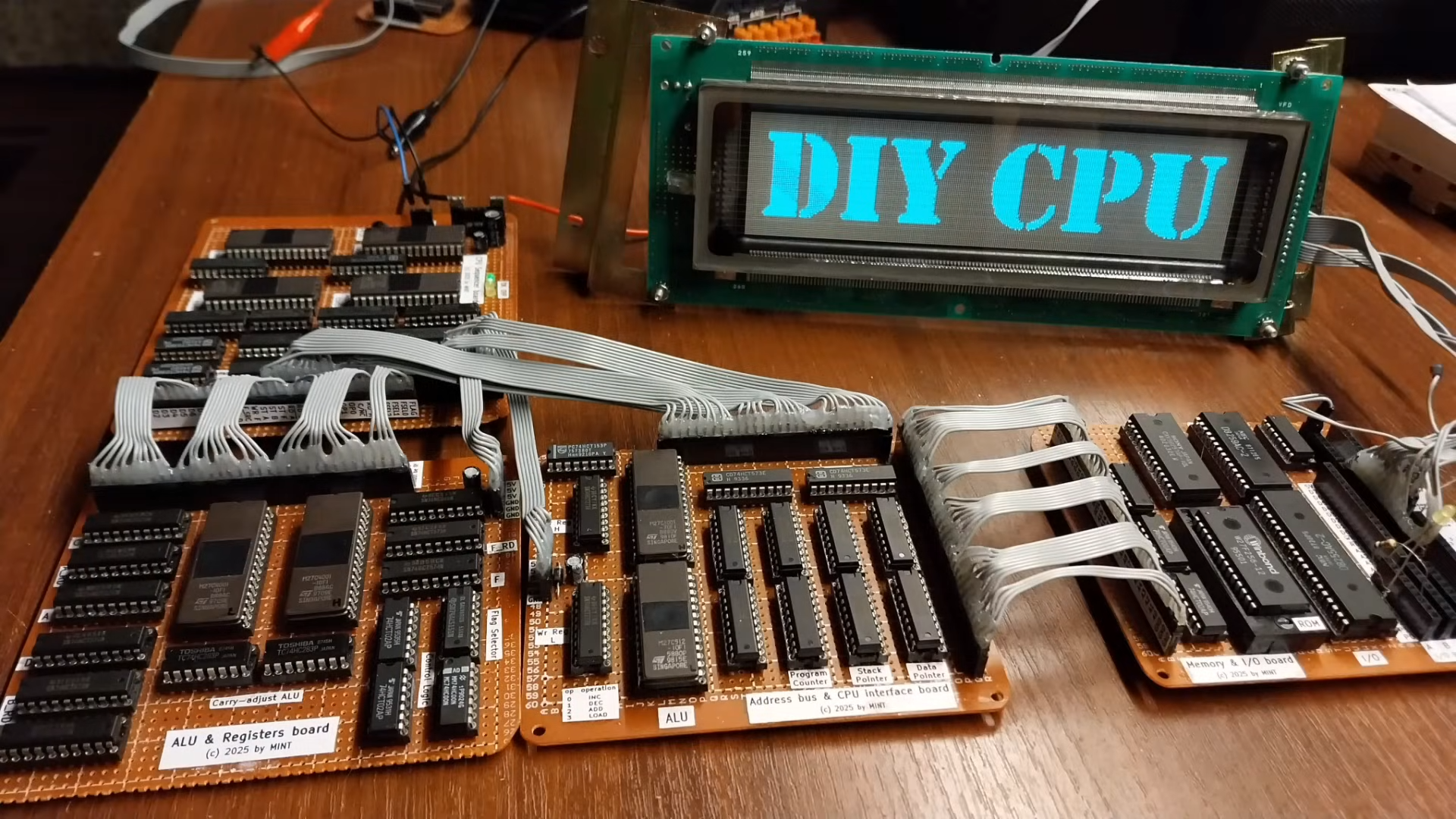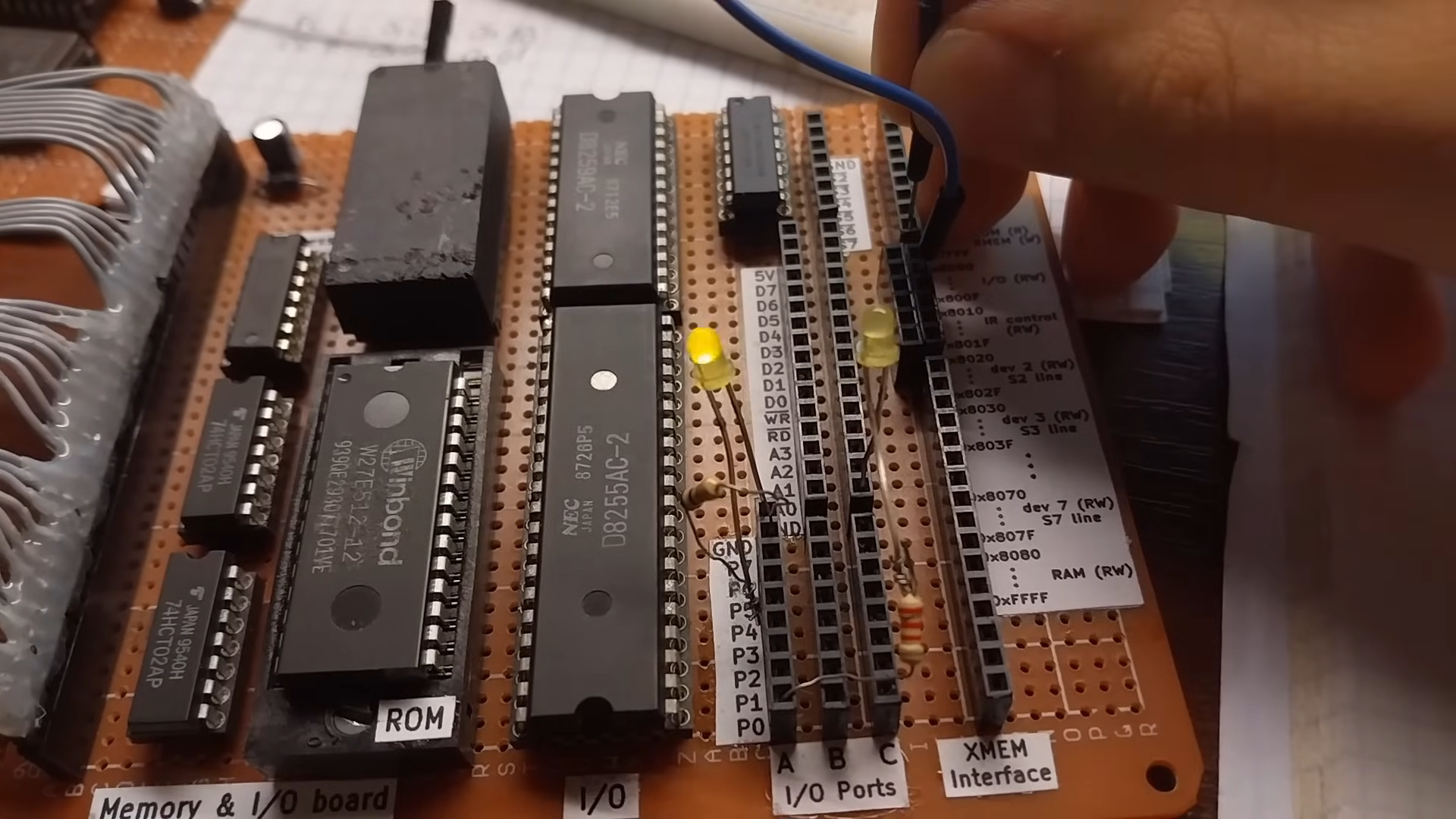Enthusiast builds a fully functional CPU from old memory chips — hand-solders every wire, writes 1800 lines of assembler code, and makes it play The Matrix on a VFD display

At first glance, this mess of wires, onboard components, and manually soldered circuits may seem like some sort of cyberpunk sculpture, but it's actually a project that can only be described as absurdly brilliant. A passionate enthusiast has just built an entire processor—yes, not a development board, not a microcontroller, but a full-on, instruction-capable, memory-addressing CPU using nothing but old memory chips and logic components from the 8-bit era. It wasn’t designed to replace a modern CPU, but rather a "fun" DIY project, dubbed the EPROMINT.
The creator behind this astonishing project, Majsterkowanie i nie tylko (or MINT for short, "DIY and more" in English), spent three months designing, wiring, programming, and documenting every last detail of the processor’s architecture. The idea was born from a simple experiment using obsolete memory chips called EPROMs, originally configured to control small external systems, like a PWM dimmer or a message display. The simplicity of that setup lit a spark. If memory could be used to simulate basic logic, then perhaps the building blocks of a complete processor weren’t so far off.
Not long after, the hobbyist found himself knee-deep in schematics, replicating the structure of classic CPUs from the 8-bit era, specifically those like the Z80, which helped ignite the personal computer revolution. The result is a machine that may not look sleek or polished, but functions according to real instruction sets, executes its own assembler code, and reacts to hardware interrupts just like a commercial processor would.
The project started with the most basic component of any processor: the Arithmetic Logic Unit (ALU). The first prototype, built to handle simple addition, was unreliable and had to be scrapped. Its replacement was fully socketed for easier debugging. From there, the build expanded to include a memory interface, an address bus controller—driven by a secondary ALU—and eventually the control logic, which decodes opcodes and coordinates the entire data flow.
The software was also written entirely from scratch. Nearly 2,000 lines of code were developed to define how the processor handles instructions, streamline how data moves through the system, and create testing procedures—all built using a custom set of development tools made for earlier circuit boards. The instruction set went well beyond what old-school CPUs could do, including operations like multiplication, division, trigonometric calculations, and even handling sequences of bits. As the creator put it, the processor was “dosed with steroids.”

With all the modules connected, the CPU was powered on for the first time, drawing 250mA of current. The same development setup previously used for other memory chip experiments was adapted to generate a complete set of instructions for the new processor. As you can see above, a blinking LED acted as the first test program while the second LED was connected to light up when an interrupt was detected, demonstrating that the CPU could handle external events even while executing instructions. It would temporarily halt its current operation, process the interrupt, and then pick up exactly where it left off, just like a real processor.
In the end, the newly birthed CPU spanned four full-sized perfboards, weighed over 500g, and contained more than a kilometer of wire if laid out. Every logic operation was implemented using pre-programmed memory. So instead of using physical NAND gates made in silicon, the system sends an 8-bit input to an EPROM, which returns the result from a stored lookup table. Functions like data routing and instruction decoding all rely on this method. To demonstrate that the system worked, he connected it to a VFD screen and wrote code to play The Matrix... or at least, low-res fragments of it.
Get Tom's Hardware's best news and in-depth reviews, straight to your inbox.



Unlike silicon buried inside a modern SoC, this processor's execution path is completely exposed. Every clock cycle, every opcode, and all register changes are visible and traceable. That’s part of the beauty. This is DIY in the truest, most punk-rock sense of the word. Watching this video makes you realize how the CPUs inside our own computers are like magic—billions of transistors dancing across the finest grains of sand, puppeteered by glass and sheer human will. If building a basic processor is this difficult, just imagine the scale of manufacturing ambition companies like TSMC have achieved. If you'd like to see similar DIY accomplishments, check out the unofficial Steam Controller 2 made from a spliced-up Steam Deck, or an RTX 5090 being brought back to life.
Follow Tom's Hardware on Google News to get our up-to-date news, analysis, and reviews in your feeds. Make sure to click the Follow button.

Hassam Nasir is a die-hard hardware enthusiast with years of experience as a tech editor and writer, focusing on detailed CPU comparisons and general hardware news. When he’s not working, you’ll find him bending tubes for his ever-evolving custom water-loop gaming rig or benchmarking the latest CPUs and GPUs just for fun.
-
bit_user When I started dabbling with digital circuits, I very quickly moved from breadboards to schematic simulation programs. Way faster and easier, more scalable, and not limited by bench space or what components you had on hand. And that was like 30 years ago.Reply
This is a cool hack, though. Impressive commitment to see it through to a fully-working system. The lookup-table approach obviously doesn't get you very far, but it's okay for 8-bit. One interesting consequence is that expensive operations, like integer division, take just as long as cheap ones, like addition or bit-wise ops. As for things like trig functions, are these just 8-bit approximations? Seems hard to believe it actually implements IEEE754 floating point.
I'm guessing that playback of the Matrix was just blitting some frames that were either uncompressed or cheaply-compressed, because there's no way this thing has the horsepower to decompress any sort of modern video codec. -
MisterZ Why was the title of this article changed? Originally it read: "Madman builds a fully functional CPU from old memory chips"Reply -
bit_user Reply
I'd guess that it's because calling someone a "madman" could be offensive. It's a little eccentric to do something like this, but really shouldn't be associated with mental illness.MisterZ said:Why was the title of this article changed? Originally it read: "Madman builds a fully functional CPU from old memory chips" -
JRStern I don't understand what he did.Reply
Somewhere you need to add some logic, which may be extremely limited but it still has to be there.
The rest is just building a minimal Turing Machine, which can indeed be very simple.
But he didn't stop at simple if he built in trig functions ...
... but I still don't get what was done, or why. -
bit_user Reply
Yeah, it does. However, most of the ALU is implemented using lookup tables in the memories. As far as I understand it, his idea is basically to use lookup tables wherever possible and minimize the amount of actual logic.JRStern said:I don't understand what he did.
Somewhere you need to add some logic, which may be extremely limited but it still has to be there.
Sometimes, you get an idea for how to do something and want to try and see if it actually works. Then, maybe you want to see how far you can push it (i.e. how well it scales). Even if it doesn't pan out, you can usually learn something in the process. Simply asking "what if?" can lead a lot of interesting places.JRStern said:... but I still don't get what was done, or why.
While this architecture makes zero sense for classical digital computers, perhaps it would make a lot more sense in a domain like biological computation or optical computing? -
davet542 Reply
Ben Eater (eater.net) and James Bates (https://www.youtube.com/@jimmyb998) did this 7 years ago using breadboards, logic chips and eproms. They did an excellent job of documenting their designs. Although this computer sounds to be more elaborate, Ben Eater's and James Bates' work should have been acknowledged. The article implies that this builder had done something new. Others have even made circuit boards of the Ben Eater/James Bates design.Admin said:Someone just built a fully functional CPU from scratch using old memory chips and logic parts from the 8-bit era. Spanning four perfboards and over a kilometer of wire, it runs real code, handles interrupts, and even plays The Matrix—all using logic simulated entirely through EPROMs.
Passionate enthusiast builds a fully functional processor out of old memory chips — hand-solders every wire, writes 1800 lines of assembler code, a... : Read more -
bit_user Reply
Fair, but there are few truly novel ideas in tech. All of these underlying ideas go way back, many decades, even if (and I wouldn't bet on this) nobody took it to the logical extreme that we see in these examples.davet542 said:Ben Eater's and James Bates' work should have been acknowledged. The article implies that this builder had done something new. Others have even made circuit boards of the Ben Eater/James Bates design.
